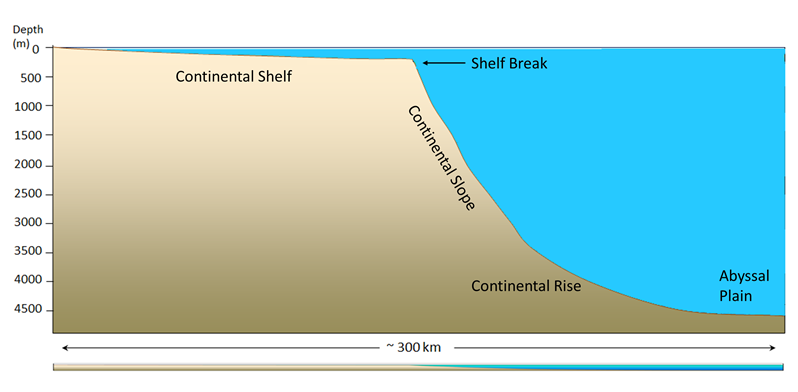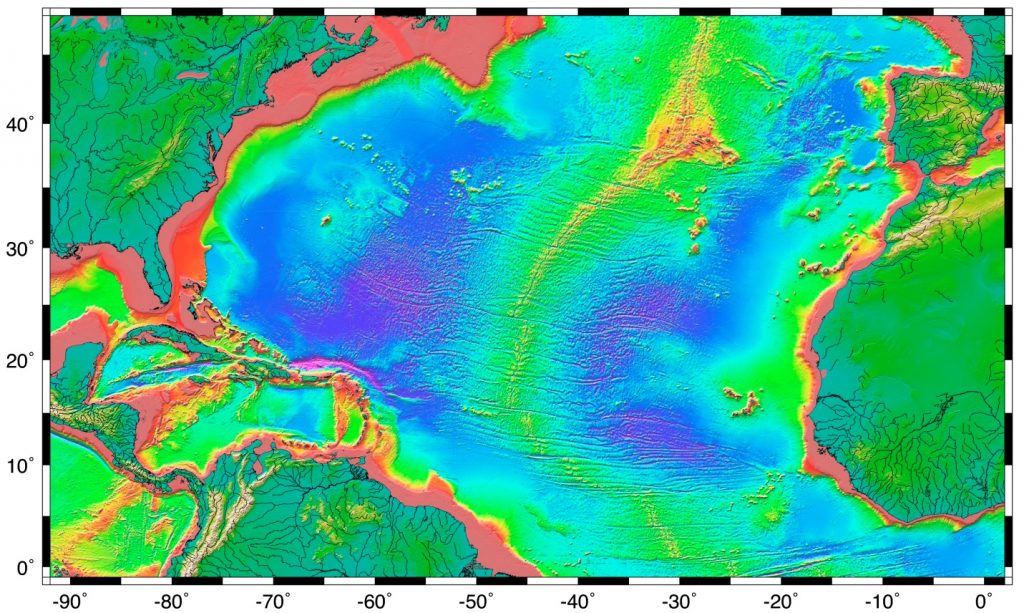What Is The Continental Margin
i.2 Continental Margins
Portions modified from "Concrete Geology" by Steven Earle*
refer to the region of transition from the land to the deep seafloor, i.eastward. between and . In an , the boundary between the continent and the bounding main is as well a purlieus, so at that place is a lot of geological activity around the margin. The west declension of the U.s. is an example of an active margin, where the coastline corresponds with the purlieus between the Pacific and North America Plates. A occurs where the transition from land to sea is not associated with a plate boundary. The due east coast of the United States is a skilful instance; the plate boundary is located along the mid Atlantic ridge, far from the coast. Passive margins are less geologically active. Effigy 1.2.ane shows an idealized passive margin. When examining this effigy, and others like it, note that there is pregnant vertical exaggeration; the depth scale covers approximately 5000 m, while the horizontal scale extends around 300 km. This makes the features look much steeper than they actually are. The bar at the lesser of Effigy 1.2.1 shows what a passive margin would wait like without this exaggeration; there is a much more gradual transition to depth.

The is the shallow, flooded edge of the continent. Geologically the shelf is even so part of the continental crust, just it is oft overlaid with marine . On average, the shelf extends about fourscore km from the coast; some margins take very fiddling shelf, while the Siberian Shelf in the Arctic extends roughly 1500 km. The depth of the shelf generally remains below virtually 150 thousand, and the floor of the shelf is fairly flat. The flat topography is the effect of changes in sea level; throughout history the shelves have been both submerged and exposed, and as body of water level rose and fell, wave activity, ice sheets, and other erosional processes smoothed out the shelf surface. Moving ridge action and the movement of sediments over the shelf have connected this smoothing process. Continental shelves simply brand upwardly about 6% of the ocean's surface area, but they are biologically one of the richest parts of the ocean; their shallow depth prevents from sinking out, and their proximity to the coast provides pregnant nutrient input. The continental shelf ends at the , which is the point where the angle of the seafloor begins to go steeper. The shelf break averages most 135 grand deep.
After the shelf break, the seafloor takes on a steeper angle (nigh 4o) as information technology descends to the deep ocean. This steeper portion of the margin is the , and information technology extends from the shelf break downwards to 3000-5000m. In some parts of the ocean, large submarine canyons have been carved into the continental slope; for example, Monterey Canyon in Monterey Bay, California, is a submarine canyon similar in size to the Grand Canyon! These canyons may be carved out past , which are essentially landslides of sediment, rocks, and other debris down the face up of the gradient.
At the bottom of the slope is the . This surface area represents where the continental crust meets the oceanic chaff, as the gradient begins to level off to go the deep ocean floor. The rise consists of a thick layer of accumulated sediment coming from the continent, so it is hard to tell where the slope ends and the ascent begins.
Subsequently the ascent comes the , or the deep body of water flooring, lying betwixt 4500 – 6000 m. The abyssal plain includes nigh of the body of water floor, and is the flattest region on Globe. It is flat due to millions of years of sediment accumulation on the bottom, which buries many bottom features (Effigy 1.2.ii).

Passive margins, as described higher up, have wide shelves, gentle slopes, and a well-developed rise. Since passive margins are non plate boundaries, they experience long periods of relative stability which tin pb to the development of these features. Active margins have similar features to passive margins, but the plate boundary affects the properties of the features. Active margins, similar the Pacific coast of North America, accept narrower shelves, steeper slopes, and little to no ascent, specially in . Trenches associated with human action as sediment traps, preventing the accumulation of a continental rise, and keeping sediments off of the abyssal plains.
* "Physical Geology" by Steven Earle used under a CC-Past 4.0 international license. Download this book for gratis at http://open.bccampus.ca
What Is The Continental Margin,
Source: https://rwu.pressbooks.pub/webboceanography/chapter/1-2-continental-margins/
Posted by: mesabour1992.blogspot.com


0 Response to "What Is The Continental Margin"
Post a Comment